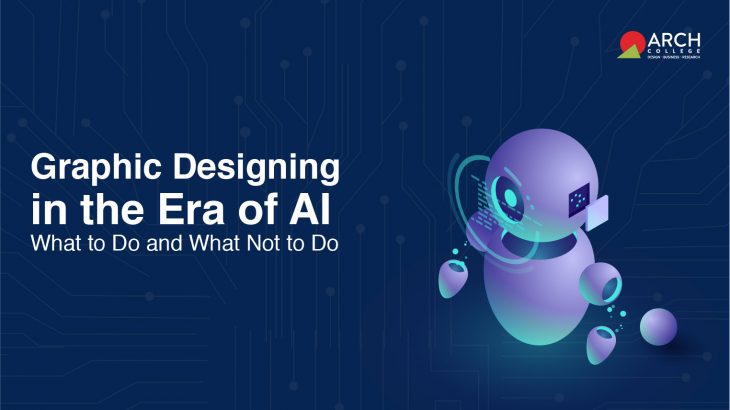The field of graphic design is going through a radical change in today’s world of fast change, where technology and creativity converge. Graphic designers are both excited and nervous about the arrival of artificial intelligence (AI), as the sector negotiates the incorporation of AI technologies into the creative process.
Understanding the delicate balance between human creativity and AI support is crucial as candidates look for Graphic Design Courses from renowned graphic design degree colleges like ARCH College of Design & Business to refine their skills they possess. The article explores the field of graphic design in the AI era and provides recommendations on what to do and what not to do to take advantage of this dynamic synergy.
Embrace AI as a Collaborator, Not a Replacement
The emergence of AI in graphic design does not foreshadow the end of creative human imagination. Instead, it offers a special chance for cooperation. While AI is capable of quickly creating templates and carrying out repetitive tasks, genuine creativity and uniqueness still come from human brains. Aspiring designers should be aware that AI technologies are available to enhance their talents rather than to replace them before enrolling in graphic designing courses. AI-generated pieces may serve as a starting point for designers to refine, customize, and add a personal touch, creating designs that connect with consumers more deeply.
Crafting Personalized Experiences Through AI
Designers now have the ability to create highly personalized visual experiences thanks to AI. By adapting their designs to consumer preferences, brands are taking advantage of this. Designers ought to, however, exercise caution. Overuse of AI-generated customization might result in cold and robotic designs. Potential designers should learn to find a balance by fusing their instincts with AI’s data-driven knowledge to create designs that connect with users personally while retaining a human touch.
Mastering AI Tools: A Necessity, Not an Option
Being able to use AI technologies effectively is essential if you want to remain current in the graphic design field. A Bachelor’s Degree in Graphic Design with an AI-infused curriculum is very beneficial. ARCH offers graphic design degrees with AI-related training to provide students the knowledge they need to use these technologies efficiently. A graphic designer could remain competitive in a sector where mastery of both conventional design and AI-driven design is essential by enrolling in degree programmes that provide practical experience with AI tools.
Ethical Considerations in AI-Infused Design
Even if AI has great efficiency, it’s important to discuss the ethical issues it raises. Some AI techniques can inadvertently reinforce biases that were present in the training data. It’s vital for designers to evaluate AI-generated fragments for any unintentional prejudices or biases. Designers have the moral obligation to modify and alter AI outputs as necessary to promote inclusion and justice.
Avoid the Homogenization Trap
One pitfall of excessive AI usage is the risk of creating designs that lack diversity and uniqueness. AI algorithms often learn from existing data, which can inadvertently lead to a homogenization of design styles. Designers must guard against this by infusing their work with innovative ideas that break free from AI-generated norms. Graphic Designing Degree Courses at ARCH College of Design & Business that encourage experimentation and unconventional thinking can help budding designers avoid the homogenization trap and stand out in a sea of similarity.
Maintain a Holistic Skill Set
Beyond the scope of AI, graphic design is a multidimensional subject. The maintenance of a comprehensive skill set is just as crucial as learning AI technologies. Conventional design abilities like typography, color theory, and layout composition should continue to be refined by designers. Designers can collaborate on a variety of tasks and provide thorough solutions that stand up to customer expectations thanks to the blend of conventional and AI-driven design aptitudes.
Infusing Emotion and Storytelling
Infusing designs with emotion and narrative is one area where human creativity outperforms AI. The capacity to transform complicated tales and emotions into visually appealing pieces is fundamental in designers. Instead of trying to replace the emotional attachment that a well-executed human touch adds to a design, aspiring designers can embrace this power and use AI as a tool for strengthening these feelings.
Collaborate Across Disciplines
Graphic design seldom takes place in solitude. To bring their ideas to reality, designers often work with authors, marketers, developers, and other experts. These partnerships are improved by AI integration since it provides data-driven insights that guide design choices. Designers must, however, develop strong cross-disciplinary communication skills and an awareness of the strengths and weaknesses of AI. Avoiding misconceptions and using the full potential of AI-augmented design initiatives requires a multidisciplinary approach.
Conclusion
The era of AI in graphic design is not about choosing between human creativity and technology; it’s about harmonizing the two to create unparalleled visual experiences. By mastering AI tools, staying ethically conscious, maintaining a diverse skill set, and infusing designs with human emotion and storytelling, designers can navigate this evolving landscape with confidence.
Aspiring designers seeking graphic design courses should enroll at ARCH to perceive AI as a tool that enhances their capabilities rather than replacing them. The future of graphic design lies at the crossroads of human ingenuity and AI innovation which experts at ARCH are well aware of. Here, those who strike the right balance between the two will undoubtedly shape the industry’s trajectory!
